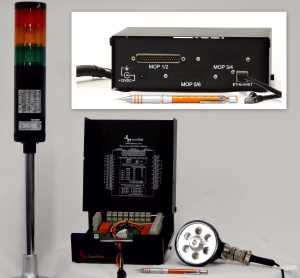Home > Products > Product and Process Monitoring > Total Vu™ HMI > Total Vu™ I/O Options
Total Vu™ HMI - I/O Options
Total Vu™ Capabilities
Reports using Excel ® templates
Max/Min for irregular and non-round profile measurement
Open Productivity and Connectivity (OPC®) software
Fast Fourier Transforms (FFT) and Structural Return Loss (SRL)
LaserLinc offers a range of input and output options beyond those for laser micrometer and ultrasonic measurement devices. They include:
- Analog Input
- Analog Output
- Closed Loop Control
- Digital Input
- Digital (Relay) Output
- Encoder Input
- Serial (RS232/RS422/RS485/Modbus RTU) Input
- Serial Output
These additional inputs and outputs satisfy virtually any auxiliary application requirement. Contact LaserLinc to learn more about any of these I/O options.
Analog Input (Back to Top)
Monitor process parameters represented by a DC voltage:
- Temperatures
- Pressures
- Loads
- RPMs
- Strain
- Tension
These additional measurements can be graphed, logged, analyzed statistically, compared against specifications, etc., as is done with diameter, wall thickness, and other measurements.
Tracking these process parameters along with product dimensions can be critically important for gaining process knowledge and improving the process.
Analog Output (Back to Top)
Convey measurement values represented as DC voltage or current to devices such as PLCs, strip chart recorders, and data loggers. A variety of hardware is available with different resolutions, voltage ranges, update rates, and channel counts.
Closed-Loop Control (Back to Top)
Automatically adjust a process parameters such as line speed to maintain a measured product dimension within specification. Read more about the control module here, including hardware interface options.
Digital Input (Back to Top)
Automatically trigger actions within the Total Vu HMI from a PLC, discrete control such as an E-stop button or foot-pedal, or from equipment such as an automatic spool changer.
Digital Output (Relay Output) (Back to Top)
Switch external AC or DC voltage signals on or off based on selectable status conditions such as an out-of-tolerance measurement or a device error. These outputs are frequently used to actuate lights, buzzers, marking devices, solenoids for sorting, and cutters.
Digital I/O offers simple automation that makes quite an impact on production efficiency.
Encoder Input (Back to Top)
Track length and speed with this input. The following are some of the useful operational benefits of encoder
 An encoder produces a pulsed output and each pulse represents a fixed amount of [typically linear] movement. input:
An encoder produces a pulsed output and each pulse represents a fixed amount of [typically linear] movement. input:
- Plot measurement values against length on trend charts and run charts to identify patterns and locate anomalies
- Delay process control activity by length following a correction to ensure the process has stabilized, independent of line speed
- Trigger sorting by tracking part location
- Make advanced measurements such as pitch and taper length
- Make measurement, logging, SPC sampling, and other functions operate consistently, independent of line speed
- Automatically identify defective equipment such as capstans when combined with the FFT module
Serial Input (Back to Top)
Read measurement values from smart sensors using serial input. Many devices stream measurement data via RS232/422/485 connections and if your Total Vu host PC has the hardware, these values can be accessed and treated like any others in the system: they can be graphed, logged, processed statistically, et cetera.
Tracking additional measurements can be critically important for process improvement and thorough, unified reporting of all data related to the process and product.
Serial Output (Back to Top)
Transmit measurement values to other devices via RS232/422/485 connections. (This capability is standard, provided the host PC has the serial connection hardware—hardware is not included.)
Contact Us (Back to Top)
Contact LaserLinc for help analyzing all of your I/O needs and understanding the value of complete process and product monitoring.
Microsoft, Excel, and Windows are either registered trademarks or trademarks
of Microsoft Corporation in the United States and/or other countries.
OPC is a registered trademark of the OPC Foundation



